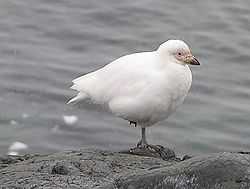Snowy Sheathbill
| Snowy Sheathbill | |
|---|---|
 | |
| Conservation status | |
| Scientific classification | |
| Kingdom: | Animalia |
| Phylum: | Chordata |
| Class: | Aves |
| Order: | Charadriiformes |
| Family: | Chionididae |
| Genus: | Chionis |
| Species: | C. albus |
| Binomial name | |
| Chionis albus Gmelin, 1789 | |
| Synonyms | |
| |
The Snowy Sheathbill (Chionis albus), also known as the Greater Sheathbill, Pale-faced Sheathbill, and Paddy, is one of two species of sheathbill. It is usually found on the ground. It is Antarctica's only land bird.[3]
Description
A Snowy Sheathbill is about 380–410 mm (15–16 in) long, with a wingspan of 760–800 mm (30–31 in). It is pure white except for its pink, warty face; its Latin name translates to "snow white".[4]
Range
The Snowy Sheathbill lives in Antarctica, the Scotia Arc, the South Orkneys, and South Georgia. Snowy Sheathbills living very far south migrate north in winter.[3]
Feeding
The Snowy Sheathbill does not have webbed feet. It finds its food on the land. It is an omnivore, a scavenger, and a kleptoparasite. It steals krill and fish from penguins and sometimes eats their eggs and down-covered chicks. It also eats carrion, animal feces, and, where available, human waste. It has been known to eat tapeworms that have been living in a Chinstrap Penguin's intestine.[4]
Gallery
References
- ↑ BirdLife International (2012). "Chionis albus". IUCN Red List of Threatened Species. Version 2013.2. International Union for Conservation of Nature. Retrieved 26 November 2013.
- ↑ The Internet Bird Collection. "Pale-faced Sheathbill (Chionis alba)".
- ↑ 3.0 3.1 Briggs, Mike; Briggs, Peggy (2004). The Encyclopedia of World Wildlife. Parragon Publishing. ISBN 1-4054-3679-4.
- ↑ 4.0 4.1 Lynch, Wayne (September 26, 2001). The Scoop on Poop. Fifth House Books. ISBN 1-894004-59-0.
| Wikimedia Commons has media related to Chionis alba. |
| Wikispecies has information related to: Chionis alba |


.jpg)
.jpg)
